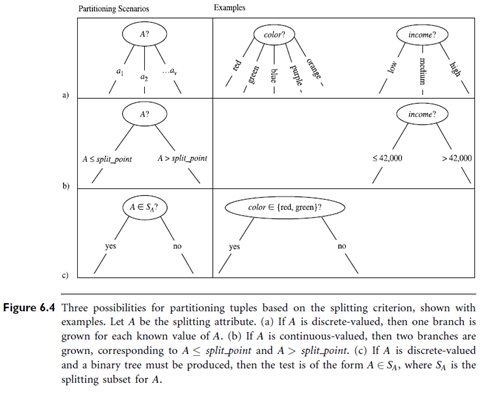SKEDSOFT
- If the tuples in D are all of the same class, then node N becomes a leaf and is labeled with that class (steps 2 and 3). Note that steps 4 and 5 are terminating conditions. All of the terminating conditions are explained at the end of the algorithm.
- Otherwise, the algorithm calls Attribute selection method to determine the splitting criterion. The splitting criterion tells us which attribute to test at node N by determining the “best” way to separate or partition the tuples in D into individual classes (step 6). The splitting criterion also tells us which branches to grow from node N with respect to the outcomes of the chosen test. More specifically, the splitting criterion indicates the splitting attribute and may also indicate either a split-point or a splitting subset. The splitting criterion is determined so that, ideally, the resulting partitions at each branch are as “pure” as possible. A partition is pure if all of the tuples in it belong to the same class. In other words, if we were to split up the tuples in D according to the mutually exclusive outcomes of the splitting criterion, we hope for the resulting partitions to be as pure as possible.
- The node N is labeled with the splitting criterion, which serves as a test at the node (step 7). A branch is grown from node N for each of the outcomes of the splitting criterion. The tuples in D are partitioned accordingly (steps 10 to 11). There are three possible scenarios, as illustrated in Figure 6.4. Let A be the splitting attribute. A has v distinct values, fa1, a2, : : : , avg, based on the training data.
- A is discrete-valued: In this case, the outcomes of the test at node N correspond directly to the known values of A. A branch is created for each known value, aj, of A and labeled with that value (Figure 6.4(a)). Partition Dj is the subset of class-labeled tuples in D having value aj of A. Because all of the tuples in a given partition have the same value for A, then A need not be considered in any future partitioning of the tuples. Therefore, it is removed from attribute list (steps 8 to 9).

- A is continuous-valued: In this case, the test at node N has two possible outcomes, corresponding to the conditions A < split point and A > split point, respectively, where split point is the split-point returned by Attribute selection method as part of the splitting criterion. (In practice, the split-point, a, is often taken as the midpoint of two known adjacent values of A and therefore may not actually be a pre-existing value of A from the training data.) Two branches are grown from N and labeled according to the above outcomes (Figure 6.4(b)). The tuples are partitioned such that D1 holds the subset of class-labeled tuples in D for which Asplit point, while D2 holds the rest.
3. A is discrete-valued and a binary tree must be produced (as dictated by the attribute selection measure or algorithm being used): The test at node N is of the form “A ∈SA?”. SA is the splitting subset for A, returned by Attribute selection method as part of the splitting criterion. It is a subset of the known values of A. If a given tuple has value aj of A and if aj ∈SA, then the test at node N is satisfied. Two branches are grown from N (Figure 6.4(c)). By convention, the left branch out of N is labeled yes so that D1 corresponds to the subset of class-labeled tuples in D that satisfy the test. The right branch out of N is labeled no so that D2 corresponds to the subset of class-labeled tuples from D that do not satisfy the test.
- The algorithm uses the same process recursively to form a decision tree for the tuples at each resulting partition, Dj, of D (step 14).
The recursive partitioning stops only when any one of the following terminating conditions is true:
1.All of the tuples in partition D (represented at node N) belong to the same class (steps 2 and 3), or
2.There are no remaining attributes on which the tuples may be further partitioned (step 4). In this case, majority voting is employed (step 5). This involves converting node N into a leaf and labeling it with the most common class in D. Alternatively, the class distribution of the node tuples may be stored.
3.There are no tuples for a given branch, that is, a partition Dj is empty (step 12). In this case, a leaf is created with the majority class in D (step 13).
The resulting decision tree is returned (step 15).